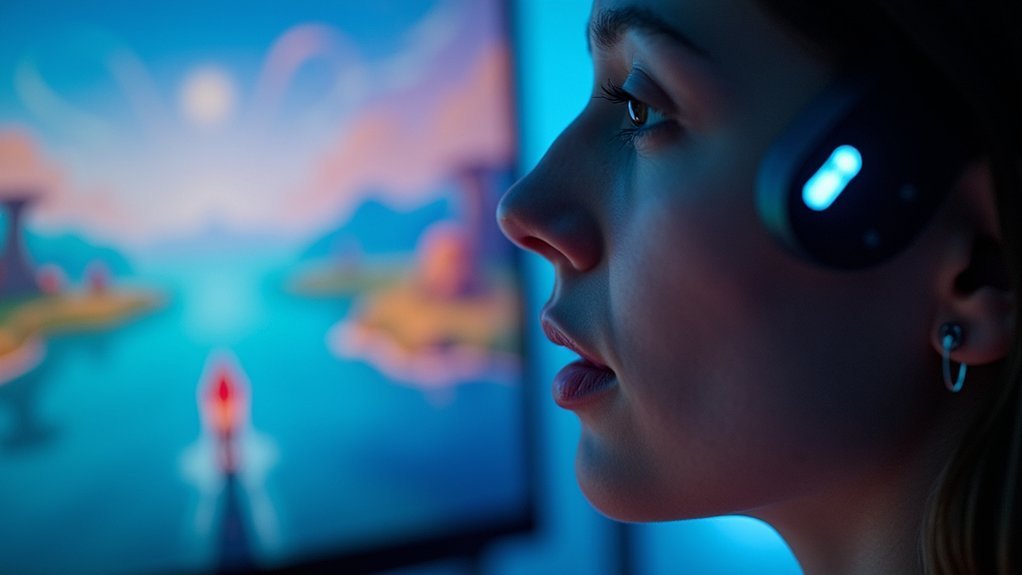Breath-controlled gaming offers a unique way to play without traditional controllers. You’ll need a breath sensor (flowmeter or modified mask) connected to a microcontroller that translates your breathing into game commands. Four primary breath actions—gale, gust, waft, and calm—can be mapped to different functions. Calibrate your device for ideal sensitivity and practice diaphragmatic breathing techniques to improve control. Beyond fun, these systems offer therapeutic benefits for respiratory health. Discover how this innovative interface can transform your gaming experience.
The Science Behind Breath-Controlled Gaming Interfaces

While traditional gaming relies on buttons, joysticks, and touchscreens, breath-controlled interfaces represent a fascinating frontier in player interaction.
These systems recognize four distinct breathing actions—gale, gust, waft, and calm—with impressive 88.3% accuracy and response times as quick as 298 milliseconds.
Modern breath-control interfaces distinguish four breathing patterns with near-90% accuracy and lightning-fast responsiveness under 300ms.
When you play breath-controlled games, you’re engaging with sophisticated biofeedback systems that monitor your breathing patterns and translate them into game commands.
The technology relies on advanced sensors and signal processing to detect subtle changes in your breath without requiring you to twist your torso, which could create data noise.
Developers have engineered these interfaces to maintain gameplay continuity even when recognition occasionally fails, ensuring your immersion isn’t broken while you experience a novel way to interact with virtual environments.
Research has demonstrated that the use of adapted gas masks provides an effective method for measuring breath flow in gaming applications.
Getting Started With Breath Sensors and Equipment
You’ll need a basic breath sensor like a flowmeter or modified mask to begin controlling games with your breath.
Before playing, calibrate your device by following manufacturer instructions and testing the sensor’s responsiveness to different breathing intensities.
If you’re technically inclined, you can also build your own DIY breath controller using pressure sensors and microcontrollers connected to your gaming system. For advanced setups, consider incorporating VOC sensors that can detect subtle changes in your breath composition for more precise control options.
Basic Sensing Devices
To enter the world of breath-controlled gaming, you’ll need to become familiar with several essential sensing technologies. Most breath control systems use either gas masks with flow sensors or mobile devices with sound sensors to accurately measure your inhalation and exhalation patterns.
These sensors capture your breathing data and transmit it wirelessly to microprocessors that integrate with gaming systems in real-time. Your breath can become a powerful controller through:
- Flow sensors that detect both direction and intensity of airflow
- Sound sensors that calculate breath magnitude through microphones
- Wearable sensors that monitor breathing rates for biofeedback
Each device offers unique capabilities for gaming applications, from simple on/off controls to nuanced interactions based on breathing patterns. Games like BreatHero demonstrate how these technologies can incorporate specific breathing techniques for attacking and defending during gameplay.
The technology’s accuracy and low latency guarantee responsive gameplay while you master this innovative control method.
Calibration and Setup
Once you’ve acquired your breath sensing device, proper calibration and setup are the next essential steps for a responsive gaming experience.
Begin by accessing your device’s utility mode to adjust baseline parameters and assign the correct MIDI channels for peak communication.
Position your sensor at a comfortable distance and angle, ensuring your environment is free from disrupting airflows like fans.
Map the breath output to your desired game functions through controller assignment menus, adjusting sensitivity thresholds to filter unwanted inputs.
Test your setup with controlled breathing while monitoring the signal response through visualization tools.
Fine-tune response curves based on your preferences—linear for precise control or exponential for dynamic range.
Save your settings as profiles for quick switching between games without recalibration.
Remember to maintain good posture for consistent breathing patterns during gameplay.
For more precise breath control, consider changing your breath controller from default CC2 to Main Volume 7 or Expression 11 for enhanced dynamic response.
DIY Breath Controllers
Creating your own breath controller opens up a world of customizable gaming options at a fraction of commercial costs. With just a few affordable components like ESP8266 microcontrollers, CNY70 optical sensors, and recycled materials, you can build a functional breath sensor for under $10.
The most accessible designs utilize:
- Corrugated cardboard for the housing structure
- Balloon membranes to detect pressure changes
- Optical or pressure sensors to convert breath to digital signals
Start by selecting your preferred sensor type—optical sensors detect membrane movement, while pressure sensors measure airflow directly. These breath controllers typically send continuous controller signals to manage volume and dynamics without note selection.
Connect your sensor to a microcontroller programmed to translate breath intensity into MIDI signals. For beginners, Arduino-based setups offer the simplest programming environment, with plenty of online tutorials guiding you through both hardware assembly and software integration.
Mastering Different Breathing Techniques for Game Control
You’ll need to master both deep diaphragmatic breathing and quick shallow techniques to optimize your breath-based game control experience.
Strategic breath holding, as found in patterns like 4-7-8 or Box Breathing, can create distinct input signals during intense gameplay moments. The gap between breaths, although initially uncomfortable but essential, becomes easier with practice and provides crucial momentary pauses for precise control timing.
Deep Versus Shallow Techniques
When mastering breath-controlled gaming, understanding the difference between deep and shallow breathing techniques becomes essential for peak performance.
Deep breathing increases blood oxygen levels, enhancing your cognitive function and reaction time while reducing stress—all vital for maintaining focus during intense gameplay. The technique involves breathing in deeply for around four seconds, holding, and then exhaling for the same duration.
Shallow breathing, however, often occurs as an automatic stress response and can undermine your gaming performance. It diminishes focus and increases anxiety, making precise control more difficult.
To maximize your breath control capabilities:
- Practice count breathing (inhale for five counts, exhale for ten) to calm your mind during critical game moments
- Use biofeedback tools to receive real-time data on your breathing patterns
- Establish consistent breathing rhythms to improve concentration in competitive environments
Regular practice of these techniques will help you maintain control during high-pressure gaming situations.
Holding Breath Strategically
While mastering deep and shallow breathing establishes your foundational control, strategic breath holding takes your gaming abilities to the next level. This technique serves as a powerful tool for refocusing during intense gameplay moments and recovering quickly after mistakes. Athletes regularly use count breathing to regain focus during competitive play and maintain mental clarity.
| Technique | Application |
|---|---|
| Temporary Pause | Hold briefly to reset focus during critical game moments |
| Post-Mistake Recovery | Short breath hold followed by deep exhale to clear mental errors |
| Pressure Management | Strategic holds between actions to maintain composure |
When you feel yourself tilting or losing focus, implement a quick breath hold followed by an intentional exhale. Professional gamers use this method during tournaments to filter out distractions. With regular practice, you’ll develop the ability to seamlessly integrate these pauses into your gameplay, maintaining mental clarity even in high-pressure situations.
Adaptive Games Designed Specifically for Breath Control

Unlike traditional control schemes that rely on buttons or joysticks, games designed specifically for breath control offer uniquely immersive experiences that respond directly to your respiratory patterns.
These adaptive systems monitor your breathing and adjust difficulty in real-time, creating a personalized gameplay experience.
You’ll find these breath-controlled games particularly engaging as they utilize specialized peripherals like gas masks or wearable sensors to accurately measure your breath flow.
The most effective implementations include:
- Primary control systems where your breath is the main interaction method
- Secondary control schemes that enhance traditional interfaces
- Ambient control options that subtly influence gameplay based on breathing patterns
While technological challenges exist, especially for sustained play sessions, developers are creating innovative solutions that make breath control increasingly accessible and effective for various game types. Research has shown that pneumatic sip-and-puff controllers can provide meaningful respiratory benefits for individuals with cervical-level spinal cord injuries.
Health Benefits and Therapeutic Applications
Beyond their entertainment value, breath-controlled games offer significant health benefits that extend into therapeutic applications.
You’ll experience improved pulmonary function and respiratory muscle strength through regular play, which is particularly beneficial if you’re recovering from a stroke or have cervical spinal cord injuries.
These games reduce stress by promoting deep, controlled breathing patterns that trigger relaxation responses in your body.
The gamified approach increases your engagement with breathing exercises without compromising their effectiveness.
Research shows that children with asthma experience greater improvements in dynamic hyperinflation when using video game-based breathing exercises compared to conventional methods.
In clinical settings, these games show measurable improvements in pulmonary function tests and can be integrated into conventional rehabilitation programs.
Whether you’re managing psychological health challenges or working on physiological recovery, breath-controlled gaming provides an accessible approach that works in both clinical environments and at home.
Accessibility Features for Various Physical and Mental Abilities

Today’s breath-controlled gaming ecosystem embraces players across the full spectrum of physical and mental abilities through innovative adaptations. Sip-and-puff switches and Quadsticks enable hands-free gaming for those with severe mobility limitations, while adaptive controllers offer customizable setups tailored to individual needs.
Modern games increasingly include features addressing diverse abilities:
Today’s games break barriers through universal design, ensuring every player finds their path to digital adventure.
- High-contrast modes and text-to-speech options enhance gameplay for visually impaired players
- Dynamic difficulty adjustment and simplified game modes reduce cognitive barriers
- Remappable controls allow personalized configurations across platforms
These technologies work alongside specialized peripherals like head-operated switches and foot pedals to create truly inclusive gaming experiences. The Sip ‘N Puff Switch, though requiring regular cleaning, provides crucial gaming accessibility by translating breathing actions into controller inputs.
When paired with collaborative development involving accessibility experts, these innovations guarantee that breath-controlled gaming remains accessible regardless of your physical or cognitive circumstances.
Frequently Asked Questions
Can Breath Control Interfaces Be Used in Competitive Multiplayer Games?
Yes, you can use breath control in competitive multiplayer games through specialized input devices. They work well for triggering special powers or attacks while maintaining fair play with balanced gameplay mechanics and proper latency management.
How Much Do Professional Breath Control Gaming Setups Typically Cost?
Professional breath control gaming setups range from $300-500 for entry-level devices like QuadStick Singleton to over $2,000 for advanced setups. You’ll need to factor in compatible gaming PC costs ($800-1,500+) as well.
Are There Age Restrictions for Breath-Controlled Gaming Systems?
Currently, there aren’t specific age restrictions for breath-controlled gaming systems as they’re mostly experimental. You won’t find standardized guidelines, but parents should monitor usage based on their child’s capabilities and maturity.
Can Breathing Interfaces Work With Existing Popular Commercial Games?
You’d likely need modifications for most existing commercial games to work with breathing interfaces. Some developers offer modding support, while VR titles are more adaptable due to their focus on immersive control schemes.
How Do Breath Sensors Perform in High-Humidity or Cold Environments?
Breath sensors struggle in high-humidity environments due to saturation effects, reducing accuracy. In cold environments, you’ll notice decreased performance as temperature affects moisture adsorption rates. Some advanced sensors include compensation algorithms to maintain reliability in these conditions.
In Summary
Breath-controlled gaming opens a new frontier of immersive play while offering therapeutic benefits. You’ve learned how these systems work, what equipment you’ll need, and techniques to master this unique control method. Whether you’re seeking accessibility solutions or novel gameplay experiences, you’re now equipped to explore games that respond to your every breath. The future of gaming isn’t just in your hands—it’s in your lungs.





Leave a Reply